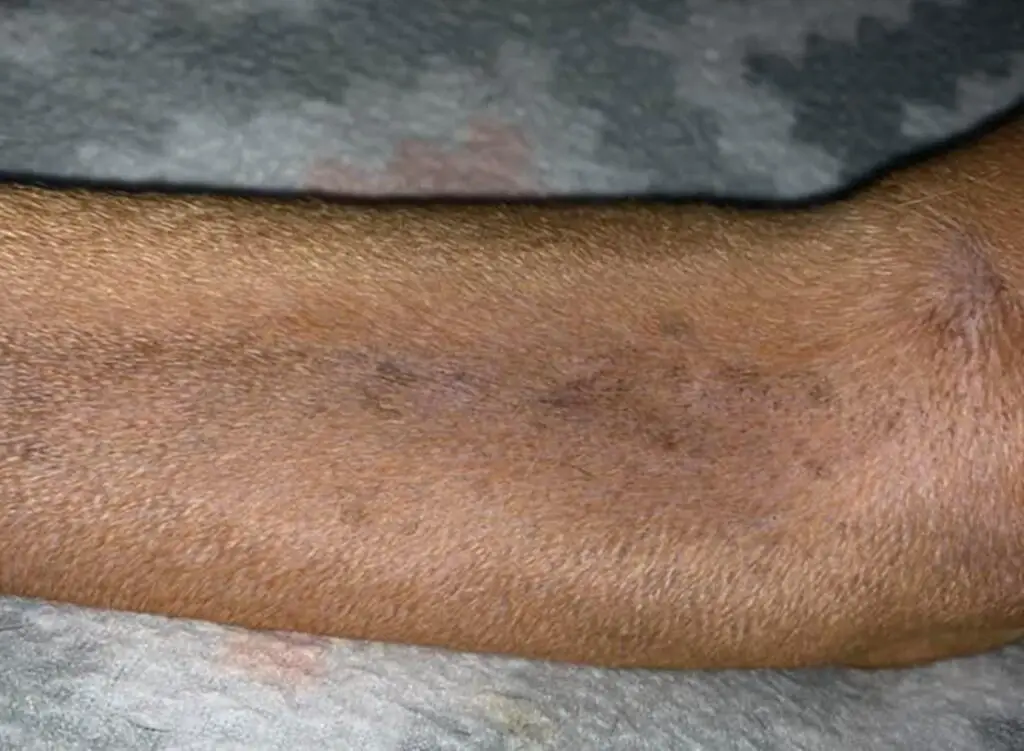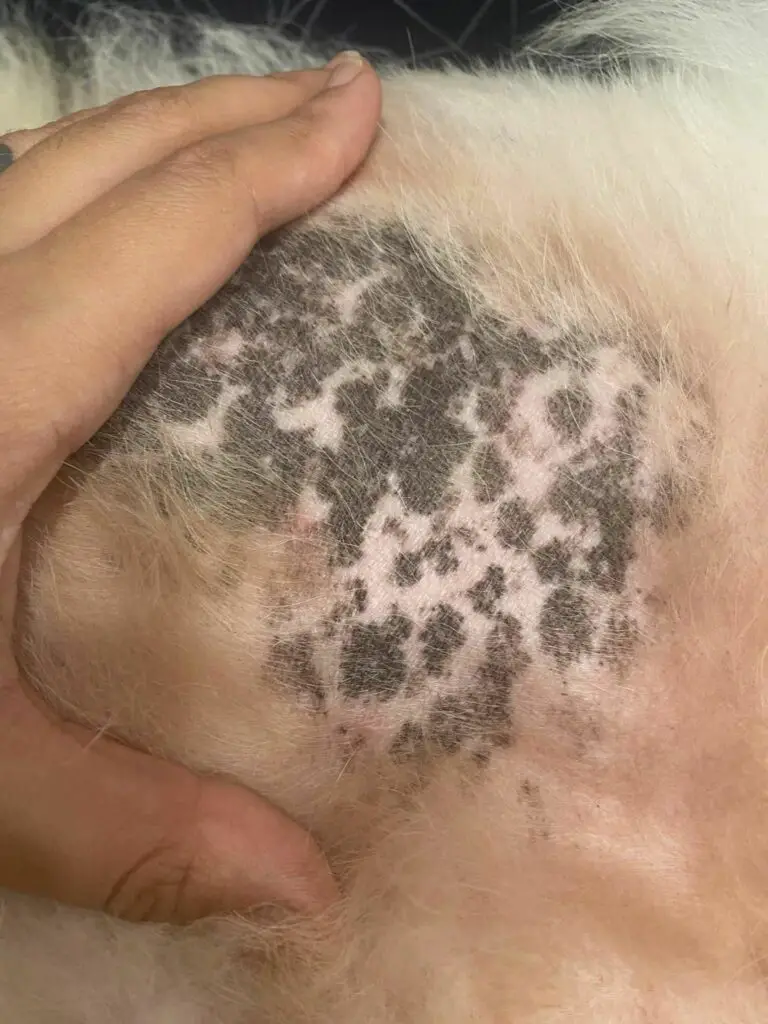Age spots in dogs, also known as melanin spots, refer to areas of discoloration on the skin of dogs.
While these spots are usually benign and do not cause any harm to the dog, it is important for pet owners to be aware of their appearance and understand their implications for their furry companions.
As dogs age, it is common for them to develop age spots. However, other factors such as breed, genetics, and overall health can also play a role in the development of these spots.
This article will provide pet owners with a comprehensive guide to age spots in dogs, including their appearance, causes, and how to care for dogs with age spots.
- Key Takeaways:
- Appearance of Age Spots
- Q: At what age do dogs get age spots?
- Q: What are age spots in dogs?
- Q: What factors can influence age spot development in dogs?
- Q: What are the signs and symptoms of age spots in dogs?
- Q: How should I care for a dog with age spots?
- Q: How do age spots differ from other skin conditions in dogs?
- Q: When should I seek veterinary care for age spots in dogs?
- Q: How can I prevent age spots in dogs?
Key Takeaways:
- Dogs typically start to develop age spots, also known as liver spots or solar lentigines, between the ages of 5 to 7 years, although this can vary depending on the dog’s breed and coat color.
- Age spots in dogs refer to areas of discoloration on their skin, also known as melanin spots.
- Regular skin checks, proper nutrition, and taking measures to protect dogs from excessive sun exposure can help prevent age spots from appearing.
At What Age Do Dogs Get Age Spots?

Dogs typically start getting age spots between 5 to 7 years old, depending on their breed and coat color.
These age spots, also known as liver spots or solar lentigines, are small dark brown areas of pigmentation that usually appear on the belly of the dog.
It’s important to note that these spots are a normal sign of aging and are not usually cause for concern.
However, any change in your pet’s skin should be monitored. While age spots are generally harmless, they can sometimes be confused with more serious conditions, such as skin cancer.
Therefore, it is always a good idea to inform your veterinarian of any changes in your pet’s health, including the development of new spots or changes in existing ones.
Sun exposure can also cause spots in dogs, even at a young age. These spots caused by the sun aren’t quite the same as age spots, but they can look similar.
Again, regular check-ups with your vet can help ensure that any spots are benign and not a sign of a more serious condition.
Understanding Age Spots in Dogs

Age spots in dogs are a common occurrence as they age, and it is essential that pet owners understand what they are and how to care for their furry companions. Age spots are also known as liver spots, and they appear as brown or black spots on the dog’s skin.
The spots usually appear on areas of the skin that are heavily pigmented, such as the ears, nose, or paws. The spots are usually harmless and a natural result of the aging process, but it is important to distinguish them from other skin conditions that may require veterinary attention.
The appearance of age spots on a dog’s skin is due to an increase in melanin, which is the pigment that gives color to the skin. The increase in melanin production is a result of the aging process and is completely normal. However, age spots can also be caused by excessive sun exposure, and dogs with lighter skin are more susceptible to them.
Appearance of Age Spots
Age spots in dogs typically appear as flat, circular, or oval-shaped dark spots anywhere from 1 to 5 millimeters in diameter. They can be black, brown, or gray, and their appearance can vary in texture and shape. While they are usually harmless, it is essential to monitor them and distinguish them from other skin conditions.
Other skin conditions that may be mistaken for age spots include tumors, infections, and allergies. It is important to seek veterinary attention if the appearance of the spots changes, if they begin to bleed or ulcerate, or if the dog exhibits discomfort or pain.
The Factors Influencing Age Spot Development

Age spots are a common occurrence in dogs, although the age at which they develop can vary depending on several factors. Here are the main factors that can influence when dogs start to develop age spots:
| Factor | Description |
|---|---|
| Breed | Some dog breeds are more prone to developing age spots than others, which can be attributed to genetic predisposition. |
| Genetics | Individual genetics play a critical role in determining when age spots appear in dogs, as some breeds may have a higher concentration of melanin in their skin, making them more prone to developing age spots at an earlier age. |
| Overall Health | A dog’s overall health can impact the development of age spots. For example, dogs with weakened immune systems may be more susceptible to developing skin conditions, including age spots. In contrast, healthy dogs may experience fewer age spots as they age. |
Age spots are more common in older dogs, typically starting to appear from the age of 5 or 6. However, they can also appear in younger dogs due to certain predispositions or conditions. It is important for pet owners to be aware of these factors and monitor their dog’s skin closely, seeking veterinary advice if age spots appear to be concerning or rapidly changing.
Signs and Symptoms of Age Spots in Dogs
- Darkened, flat spots on the skin that are brown, black or gray in color.
- The spots typically appear on areas exposed to the sun, such as the back, head, forelimbs, and hindquarters.
- Age spots usually do not cause any discomfort or itching for the dog.
- They are more common in dogs with light-colored or thin coats.
- The spots can vary in size, from tiny dots to larger patches.
- Increase in the number and size of spots as the dog ages.
- In some cases, age spots may change in texture, becoming slightly raised or rough.
Age spots in dogs are typically harmless and do not cause any discomfort to the dog. However, it is important for pet owners to be aware of the signs and symptoms of age spots in dogs in order to monitor them and ensure their furry companions’ overall health and well-being.
The most common sign of age spots in dogs is a change in skin pigmentation, which may appear as dark spots or patches. These spots can also vary in texture, with some being raised or rough to the touch. Additionally, age spots may appear more prominently on certain areas of the dog’s body, such as the face, paws, and belly.
If a pet owner notices any changes in their dog’s skin pigmentation or the appearance of dark spots, it is important to monitor these changes over time. If the spots exhibit concerning characteristics such as abnormal texture or size, or there is bleeding or ulceration, pet owners should seek veterinary advice immediately.
Caring for Dogs with Age Spots
While age spots in dogs are generally harmless, it is still important to take proper care of your furry companion’s skin. Here are some practical tips to help you care for your dog with age spots:
- Grooming: Regular grooming can help keep your dog’s skin healthy and clean, which can help prevent the appearance of age spots. Make sure to brush your dog’s coat often, paying attention to any areas where age spots have already developed. This can help remove any dead skin cells and promote healthy skin growth.
- Nutrition: A balanced diet is essential for your dog’s overall health and can also help keep their skin in optimal condition. Consider incorporating foods that are rich in vitamins and antioxidants, such as leafy greens and blueberries, into your dog’s diet. Consult with your veterinarian to determine the best diet for your furry friend.
- Sunscreen: Dogs with lighter skin may be more prone to sun-induced age spots. Consider using sunscreen when your dog is spending time outdoors to help protect their skin from harmful UV rays. You can use a dog-specific sunscreen or a child’s sunscreen that does not contain zinc oxide or para-aminobenzoic acid (PABA).
Remember, if you are unsure about any aspect of caring for your dog’s age spots, it is always best to consult with your veterinarian. They can provide specific advice based on your dog’s individual needs and help ensure that your furry companion stays happy and healthy.
Age Spots vs. Other Skin Conditions
While age spots are usually harmless, it is important to distinguish them from other skin conditions that may require medical attention. Skin allergies, infections, and cancerous growths can all exhibit similar appearances to age spots, so it is essential to monitor any changes in the dog’s skin and seek veterinary advice if unsure.
Age spots are typically flat and smooth, while cancerous growths may have an irregular shape or texture. Allergic reactions or infections can cause redness, swelling, and itching around the affected area, which is not a characteristic of age spots. Therefore, paying attention to any accompanying symptoms can help differentiate age spots from other skin conditions.
Tip: If your dog has any concerning skin abnormalities or the age spots seem to get worse over time, it’s always better to seek veterinary advice as sooner is better than later.
When to Seek Veterinary Care
While age spots in dogs are generally harmless, there are certain situations where pet owners should seek veterinary care. If you notice rapid changes in the appearance of age spots, such as sudden growth or a change in color, it is advisable to consult with a veterinarian. Bleeding or ulceration is also a concerning sign and warrants a visit to the vet.
If your dog exhibits signs of discomfort or pain, such as excessive scratching or biting of the age spots, it is essential to have them checked by a professional. Additionally, if you notice any unusual lumps or bumps on your dog’s skin that appear different from age spots, it is essential to seek veterinary care as soon as possible.
Preventing Age Spots in Dogs
While there is no surefire way to prevent age spots from developing in dogs, there are certain measures that pet owners can take to minimize the risk of their furry companions developing these spots. Here are some tips:
- Provide a balanced diet: Feeding your dog a healthy, balanced diet can help support their overall health, including their skin. Choose high-quality dog food that contains essential nutrients, vitamins, and minerals.
- Regular exercise: Regular exercise is crucial for keeping your dog healthy and preventing various age-related health issues. Make sure your dog gets enough exercise every day, whether through walks, runs, or playtime.
- Proper grooming: Regular grooming can help keep your dog’s skin healthy and reduce the risk of skin-related issues, including age spots. Brush your dog’s coat regularly and keep it clean and free of mats and tangles. Consider using dog-specific shampoos and conditioners that are gentle on their skin.
- Sun protection: Protecting your dog from excessive sun exposure can help prevent age spots, especially in dogs with lighter skin. When spending time outdoors, provide shade and consider using dog-friendly sunscreen.
By following these tips, pet owners can help promote their dog’s overall health and well-being while minimizing the likelihood of age spots developing. Remember, regular skin checks, vet visits, and careful observation are also important for keeping your dog healthy and happy as they age.
FAQ
Q: At what age do dogs get age spots?
A: Dogs typically start developing age spots as they get older, usually in their senior years. However, age spots can also appear in younger dogs due to certain predispositions or conditions.
Q: What are age spots in dogs?
A: Age spots in dogs refer to dark spots or discoloration on their skin. These spots are usually harmless and not a cause for immediate concern. It is important to distinguish age spots from other skin conditions and seek veterinary advice if unsure.
Q: What factors can influence age spot development in dogs?
A: Various factors can influence when canines develop age spots, including breed, genetics, and overall health. While age spots are more common in older dogs, they can also appear in younger dogs with certain predispositions or conditions.
Q: What are the signs and symptoms of age spots in a dog?
A: Signs and symptoms of age spots in a dog include changes in skin pigmentation, the appearance of dark spots, and potential variations in texture. Regular skin checks and monitoring of any changes in the dog’s skin are important.
Q: How should I care for a dog with age spots?
A: To care for a dog with age spots, regular grooming, proper nutrition, and the use of sunscreen for pets with lighter skin are recommended. Consulting with a veterinarian for specific advice is important in managing age spots.
Q: How do age spots differ from other skin conditions in canines?
A: Age spots differ from other common skin conditions in canines, such as allergies or infections. Understanding the differences and seeking veterinary advice if unsure or if the spots exhibit concerning characteristics is important.
Q: When should I seek veterinary care for age spots in doggos?
A: Veterinary care for age spots in dogs is recommended in situations such as rapid changes in appearance, bleeding or ulceration, or if the dog shows signs of discomfort or pain. General guidance on what to expect during a veterinary examination is important.
Q: How can I prevent age spots in pups?
A: Preventive measures to reduce the likelihood of age spots in dogs include maintaining a balanced diet, regular exercise, and proper grooming practices. Protecting dogs from excessive sun exposure, especially those with lighter skin, is also important.
Conclusion
Age spots are a common occurrence in dogs, typically appearing in older dogs but can also appear in younger dogs due to various factors. While they are generally harmless, pet owners should be aware of their appearance and monitor any changes in their dog’s skin.
Regular grooming, proper nutrition, and sun protection are practical measures that pet owners can take to reduce the likelihood of age spots in their dogs. However, if age spots exhibit concerning characteristics or cause discomfort, it is recommended to seek veterinary care.
As pet owners, it’s essential to embrace the aging process of our furry companions and provide them with the best possible care and attention. Regular skin checks and veterinary care can help ensure that age spots are detected early and treated promptly.





Leave a Reply